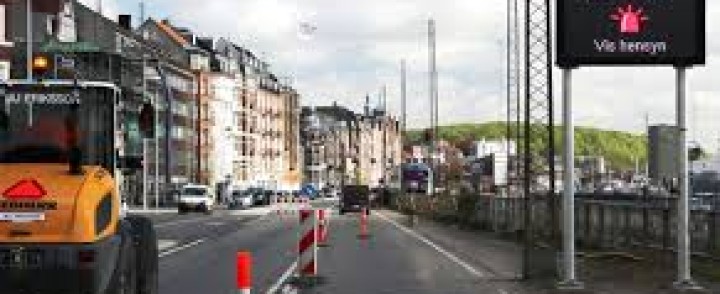Bluetooth technology reveals traffic anomalies in major Danish city
Thanks to years of collecting traffic data, based on the movement of driver´s mobile devices, Aarhus municipality in Denmark can now see the effects in road traffic of construction projects, roadwork, traffic accidents and faulty traffic lights.
Aarhus, Denmark’s second-largest city has been using BlipTrack Bluetooth sensors for several years to collect traffic information, based on the movement of road users´ Bluetooth devices. The sensors, placed on the entire road network, including adjacent highways, provides the city with both real-time and historic traffic information, including driving times, speed, dwell times and flow.
Besides the benefits of real-time reporting, which enables the city to gain in-depth insight and understanding of current road density, flow and formation of queues, and share traffic information with road users on signs, the historical data is now being used to detect driving time anomalies. Effectively, this means that the city can pinpoint road sections and intersections where driving times deviate from the norm as a result of construction projects, incidents, roadwork, faulty traffic lights and other factors.
The data provides a thorough comparison of current vs typical driving times, minute-by-minute throughout the day. The typical driving times, which are continuously updated, are based on various type of days (weekdays, weekend, vacation season or not) and time of day.
If driving times deviate from the typical driving time, the system automatically raises a flag. As the system logs and visualizes all deviations, traffic engineers can create historical performance and reliability reports based on deviations from the norm. The city is provided with an overview of the current situation and tendencies over time, to initiate countermeasures.
Alarm visualization can be displayed in various ways; for example, over time and for each road section, based on intersection errors, or the impact of a major traffic accident. It can show the scattering effect that can cause both a deterioration and improvement of driving times – depending on what alternative routes motorists choose to take advantage of – or if road users are prevented from reaching parts of roads.
“The benefits we have gained from the solution since implementation are very significant. We now discover errors and irregularities that we would not have a chance to see otherwise. In addition, it is extremely educational and easy accessible to study how the incidents of various kinds influence the road network,”says Asbjørn Halskov-Sørensen, ITS Project Manager at Aarhus Municipality.
Intersection alarm, analysis and optimization.
Aarhus has around 230 intersections regulated by traffic lights. If just one of these traffic signal installations is not working optimally or breaks down, it directly affects traffic flow in a large surrounding area.
While the many traffic light installations do have built-in alarm systems that warn about mechanical errors, such as defective bulbs, programming errors and communication trouble in the connection to other linked systems, these alarm systems are “dumb”, unable to report on the consequences of the errors or traffic regulation programs. The alarm systems cannot see whether an error is causing queue formation or longer driving times for the road users, and they cannot see whether the amount of traffic has changed over time, calling for a change to the traffic light system program. This means, for example, that sudden or continuous traffic increase could result in major gridlock, without warning.
To meet this challenge, Aarhus opted to turn the problem on its head and to see the traffic flow from road users’ perspective. Since the Bluetooth sensors measure both short and long distances, as well as the turn flow through intersections, and groups of traffic lights in the road network, the solution provides an objective, measurable expression of road users’ driving experience. Now, issues are detected, enabling the city to ensure that traffic lights are working correctly and programmed optimally.
The solution has quickly become an indispensable supplement to the existing surveillance system for the Aarhus traffic light installations. Various unfavorable situations have proven to be detectable with direct reference to driving time data, such as:
- Errors caused by incorrect activation of traffic light programs, such as the rush hour program
- Missing or lengthy activation of turn phases
- Defective surveillance systems
- Human error, such as forgetting to switch back to the normal program following maintenance
- Incorrect timing of coordination chains (“green wave”)
All these factors play a crucial role in identifying traffic signal installations that need optimization, but also in terms of what needs to be optimized and, ultimately, whether the efforts had the intended effect.
“BlipTrack data is generally used for much more than just being able to measure the effect of signal optimization and roadwork/construction projects, but this is clearly an important part of its application”, says Asbjørn Halskov-Sørensen. “Ultimately, the data contributes to an improved economy and a better environment through reduced driving times and fuel consumption, and thus reductions in greenhouse gas emissions from vehicles.”
With the new approach, Aarhus now enjoys a full overview and understanding into all dynamics of its traffic. Since the city has full access to all the raw data, unlike with similar solutions, the plan is to combine the solution with existing surveillance systems. This would enable the city to qualify the individual system’s alarms to an even greater extent.
Besides providing the city of Aarhus with visibility on driving times anomalies, the solution is also implemented in cities in UK, Sweden, Thailand, Switzerland, New Zealand, Norway, Canada and Ireland. BlipTrack also is successfully employed in optimization efforts in more than 25 international airports, including Schiphol Airport in Amsterdam, JFK Airport in New York, Copenhagen, Oslo, Manchester, Dublin, Brussels, Geneva, San Diego, Keflavik and Edinburgh. In recent years, the solution has been rolled out in train stations, ports, ski resorts, amusement parks and at events all over the world.
- Bluetooth technology reveals traffic anomalies in Aarhus, a major Danish city



